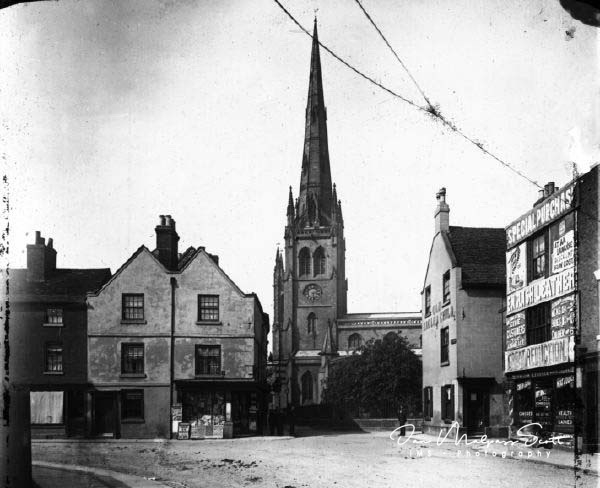Saint Alkmund’s Church was a Victorian Church, which stood in a Georgian square between Bridgegate and Queen Street in Derby; this was the only Georgian square in the city.
The church was built in 1846 by the architect Henry Isaac Stevens at a cost of £7,700 on the site of several earlier churches stretching back to the 9th century all named after Saint Alkmund. It was constructed in ashlar stone in a gothic style. Inside the church was an architectural triumph, with high pillars and stone arches. The aisle and nave were wide and the church featured a chancel. The steeple was supported by flying buttresses.
However, the building of the church caused controversy among the Catholic citizens of Derby. The 216-foot (66 m) spire was built directly in the line of sight of St Mary’s Church and, for many years, the Anglican church had the unflattering nickname of The Church of the Holy Spite. Derby painter Joseph Wright was re-buried in St Alkmund’s churchyard upon completion of the building in 1846.
The church was surrounded by many two- and three-storey townhouses that lined the square and churchyard. Other buildings of interest included The Lamb Inn, opened in 1835, which featured its own brewery and a gabled sweet shop dating from the 17th century sited on the corner of the square and Bridgegate, and several shops dating back to medieval times at the Queen Street entrance to the yard. The area was described by Sir Nikolaus Pevsner ‘A revival of 18th century unmatched, a quiet oasis.’
During the mid-1950s it was discovered that the load-bearing wood in the steeple was warping and rotting. This led to the steeple being ‘capped’ and the top 20 feet was removed for restoration work to be done. This was done due to structural weaknesses being found in the stonework and woodwork in the steeple itself. Plans were laid down to replace the top of the steeple, but was never completed. Along with the top of the spire, several of the gothic detailing pieces on the roof were also removed, but no reasons for this were ever given.
In 1963, Derby County Borough Council announced plans to improve traffic flow in the borough of Derby. Part of this scheme was to build a road that would carve through the site of the church and the churchyard, which met with strong criticism from many Derbeians.
However, the site was issued with a compulsory purchase order and demolition began in 1968. During the works, the site of the original church was uncovered, along with a tomb believed to be St Alkmund’s and several other artefacts that are now on display in Derby Museum and Art Gallery. Today, the whole site is now Derby’s inner ring road, and little trace of the church is to be found. However, a plaque has been erected in memory of the building.
A modernistic church of the same name was built on Kedleston Road in the early 1970s to replace the original building.


